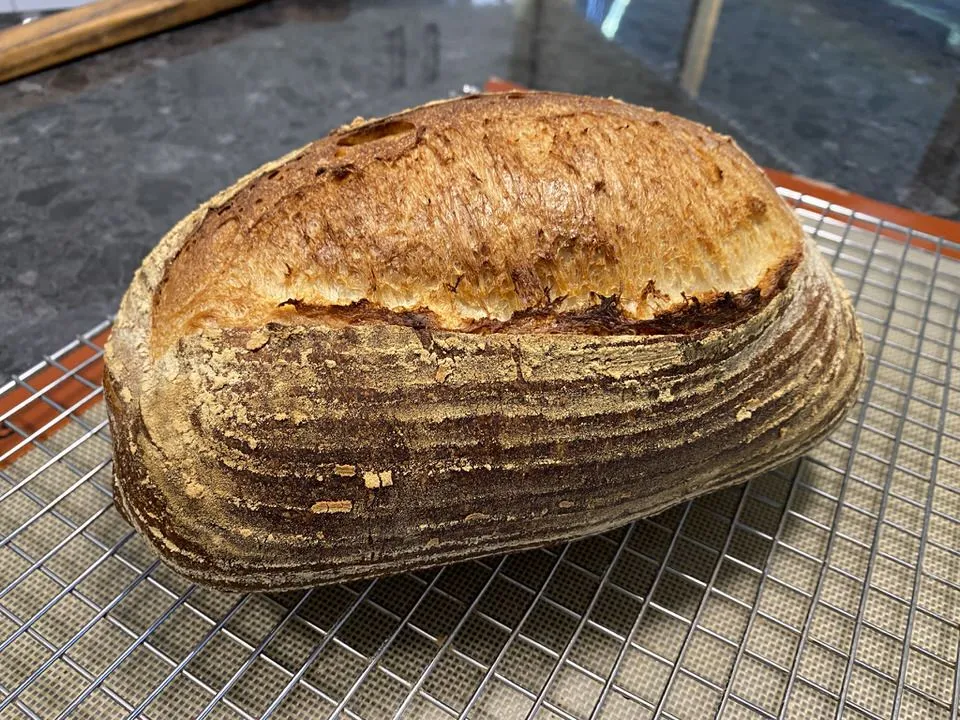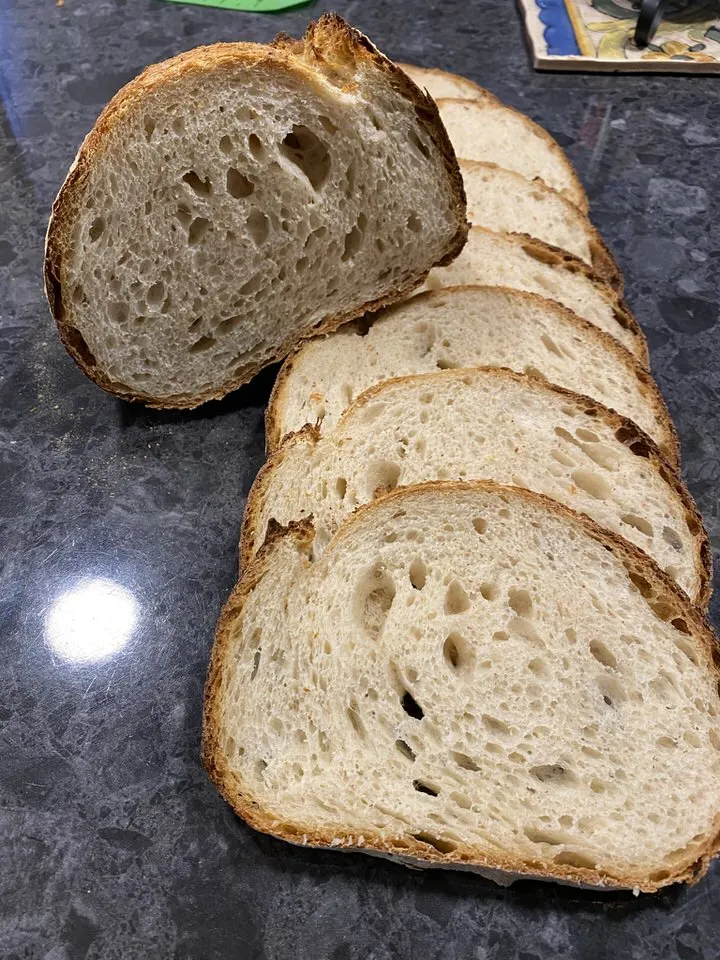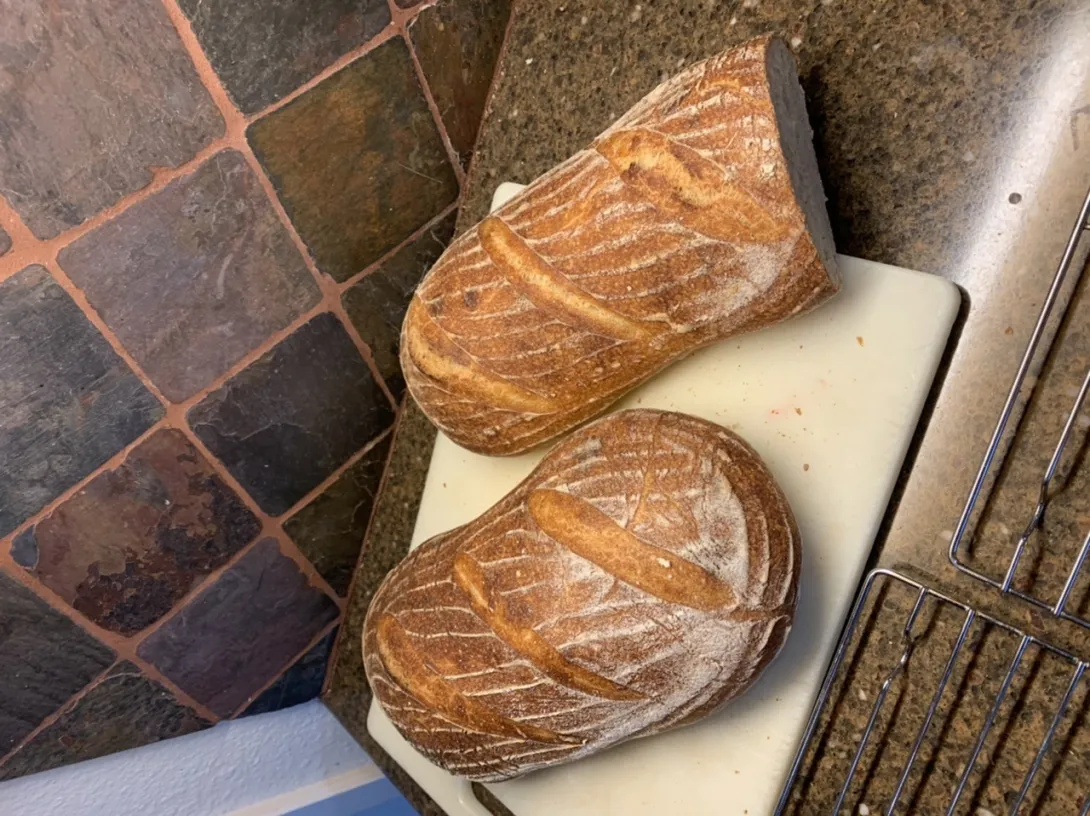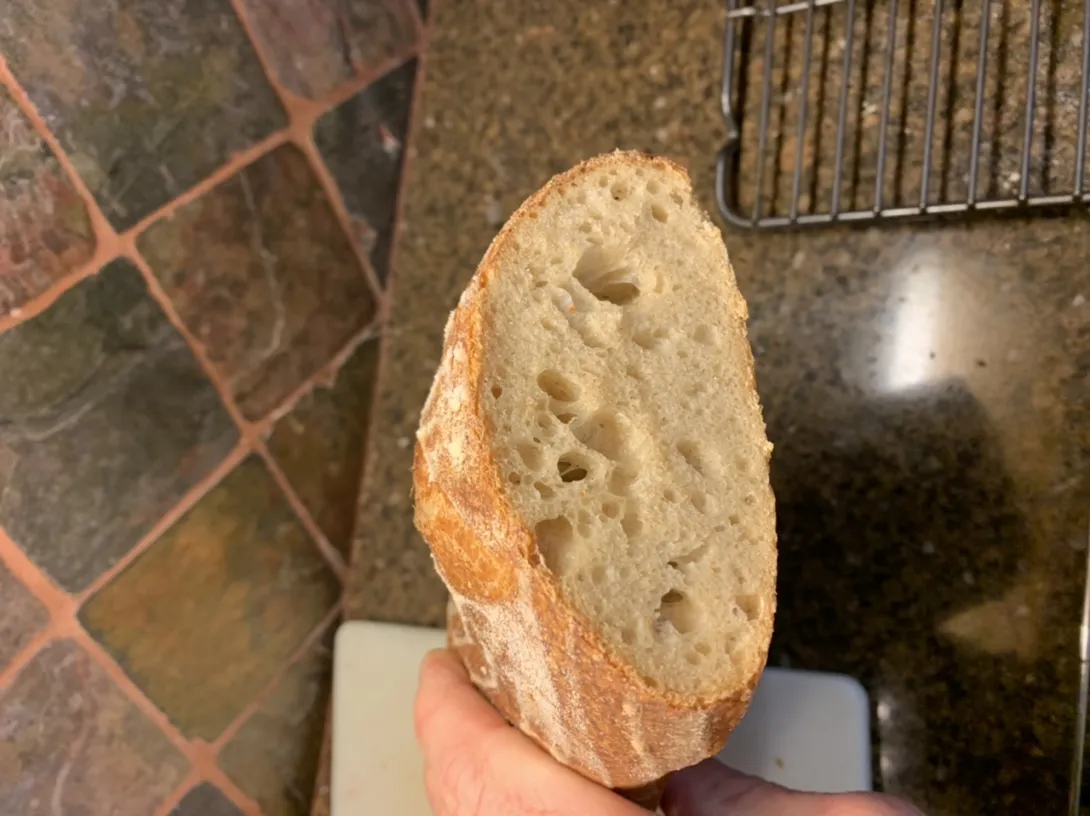
This is a 10% whole-wheat sourdough that is our everyday bread. It is great in the morning with bacon and eggs and an extra slice with vegemite or a jam. I bake it once a week or sooner if we run out. I gift a loaf to the guy next door occasionally as he mows our front nature strip when he is doing his own. A great sourdough that I have been baking for years and never misses.Cheers,Gavin

Image

- gavinc's Blog
- Log in or register to post comments
Beautiful loaf Gavin, I can see why it is your go to sourdough bread. It has a wonderful crust and crumb and you’ve certainly perfected it.
Benny
Makes a great go-to bread and after years of baking it I bet you make it without having to think about the recipe. Nice looking loaf and perfect crumb. This kind of bread will compliment anything.
Looks perfect with a nice open crumb.
Happy baking!
Thank you, fellow bakers. I occasionally sub rye in for the whole-wheat flour, but our favourite is wheat. I don't need to refer to my spreadsheet when making this anymore, it's embedded in my brain! I wake some nights after dreaming of making it. My doc has given me a certificate to say I'm sane :)
I'm thinking of giving this bread a try but am wondering if the liquid levain can be replaced by a regular 100% without the bread losing its uniqueness.
I am a newbie and therefore not comfortable with the idea of playing with my starter yet!
Thanks for sharing your thoughts,
Gaëlle
Hi, Gaëlle.
I think it would be ok, provided the overall hydration is the same. I've PM'd you a link to the spreadsheet so you alter the formula.
Cheers,
Gavin
Oh that's really kind of you !! Thanks a lot Gavin :-)
I had a look at your spreadsheet and am really amazed and grateful: that's a very impressive spreadsheet, really clear and thorough! It's going to make my life so much easier this weekend!!!
Thank you again Gavin, and please do not hesitate to let me know if you happen to have some other SD bread spreadsheets in-store that you would be willing to share with a lazy-but-passionate and forever-grateful newbie like me ;-)
I've sent you another PM. Have fun!
Cheers,
Gavin.
Gavin, et al.: I just tried Hamelman’s Vermont sourdough using whole wheat instead of rye. My only deviation from the recipe was that I adapted my 80% culture by building to 125% the night before. Dough temperature was spot-on, and I did 2.5 hours of bulk fermentation and an overnight retard in the fridge. The dough did not rise much during fermentation, and my loaves certainly didn’t spring up like yours…but overall taste great and there is a somewhat open crumb. What would you recommend I might do to achieve better results?
thanks for any pointers for this beginner,
Josh
Image

Image

Hi Josh,
The loaves look pretty good. To improve, I'd check the flour protein percent of the bread flour to be 11.5 to 12% is good. Most important is the viability of the levain to be at peak when you mix the dough. I also bake on a stone with steam. I made some notes years ago when first baking the VSD, see below.
How to get repeated success with Hamelman's Vermont Sourdough.
· Always have an active starter to build the final levain and mix the dough at its peak.
· Use baker's percentage and scale all ingredients.
· Take the time to measure the temperature of the room, flour and levain and work out the desired water temperature so you can achieve a final dough temperature after mixing of 24 to 25C.
· Use a proofing box set at 24 to 25C to maintain dough temperature. This will give you the predictability of your schedule.
· Mix to incorporate ingredients leaving out the salt. Autolyse 30-60 minutes.
· Mix to moderate gluten development.
· Perform stretch and folds during bulk fermentation. (I do two at 50-minute intervals and shape after a further 50 minutes). This will develop and strengthen the gluten framework.
· Final ferment (proof) for 2 to 2 1/2 hours; (or retard in the fridge until the next day works great for additional flavour, but not essential).
· Presteam the oven and bake in a hot oven 238C for 40 to 45 minutes. Maintain steam for about 10 minutes after loading the loaves. Lower to 215C after fifteen minutes and finish in a drying oven.
· Allow cooling before cutting.
Cheers,
Gavin.
Crust color looks good, and your crumb isn't too far off the mark. Just looks a tad underfermented --- the same look I used to get with this bread the first few times I made it. Gavin's right, the vigor and maturity of the starter do matter, as do all those other steps in his list, but there's something else to think about that isn't addressed by Jeffrey's procedure. The mass effect. I didn't realize just how much difference that can make until I forgot I had dough fermenting one day --- for a few hours. I thought my bread was going to be ruined, but it turned out much improved.
Bear in mind that Vermont Sourdough was developed and perfected at production bakery scale. Large volumes of dough generate and retain more heat than small home-sized batches. And that means that even if you hit the desired dough and air temperatures in the process notes, you probably aren't achieving the same amount of fermentation.
A larger batch of dough also takes more time to divide, preshape and shape the many loaves than 2-3 at home. And the dough continues fermenting throughout that time as well, increasing the disparity between large and small batch if you don't account for that extra time somewhere.
At the end of bulk fermentation, the dough is warmer and more active in the bakery, and once shaped, proofing loaves go into a speed rack all huddled close to each other under a plastic tent-like cover before going into a walk-in cooler. So they tend to conserve warmth longer than the couple loaves going into a home refrigerator.
I have found that if I stick to the temperatures in the book, I need to add 1 1/2 hours to the bulk fermentation, and give the shaped loaves 1/2 hour at room temp before moving to the fridge for overnight retarding. The other option is sticking with the given times but increasing the temperatures by a few degrees, both the target dough temperature and proofer setting. Of course with your starter your mileage may vary, but try increasing the time or the temperature and see what happens.
My best,
dw
…for the many good ideas. Regarding steam I poured boiling water on two pie tins filled with lava rocks. Do you have a better, more reliable technique?
I think your steaming method is good. Before our new oven, I used a similar method using a cast iron bowl. Our new oven (four years ago) has an in-built steaming function.
Debra Wink has given some very sound advice about temperature, dough mass and environment differences between the bakery and home, that is something I hadn't considered. I always heed her advice :)